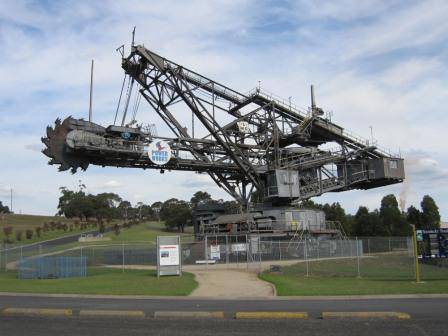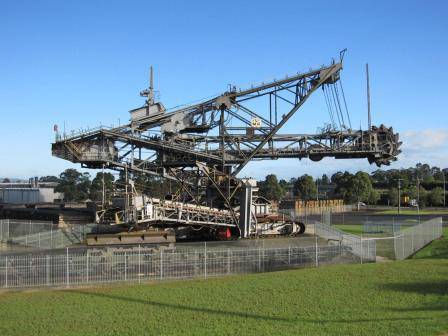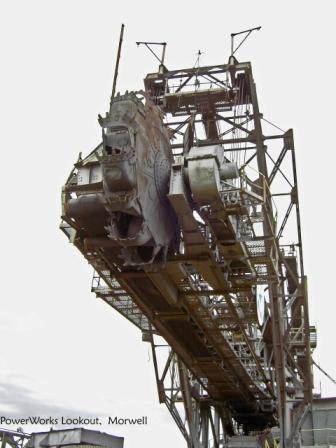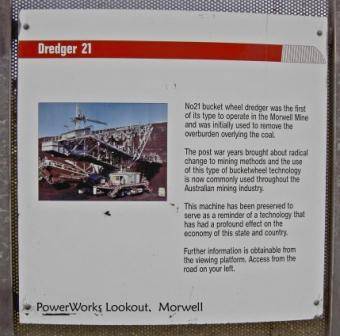| Back to search results » | Back to search page » |
|
No 21 Bucket Dredger
LocationSEC Powerworks Visitor Centre Ridge Road,, MORWELL VIC 3840 - Property No B5334
File NumberB5334LevelState |
|
Statement of Significance
What is significant? No.21 dredger built by Lubecker Maschinenbau Gesellschaft (LMG), Lubeck, Germany (serial no.1074) for the State Electricity Commission of Victoria (SECV). The dredger was ordered in 1950, and commenced operations October 1955. It is a bucket wheel excavator fitted with a slewable superstructure, a bucket wheel with crowd (thrust), mounted on crawlers, and has a service weight of 725 tons. It was used for excavating overburden and brown coal from the Morwell open cut mine until August 1992 when it was retired. It was placed on display at the Powerworks Visitors Centre in 1995.
How is it significant? No.21 Dredger is significant for historical and technical reasons at a State level.
Why is it significant? No.21 dredger is historically significant as the first bucket wheel excavator to be used at the Morwell open cut. It was designed and built specifically for the SECV by LMG Germany, and it was the second bucket wheel excavator purchased by the SECV. The Morwell open cut was a new major open cut project developed by the SECV with work starting on site in 1949. No.21 dredger is associated with a period of significant expansion by the SECV to meet the exponential growth in demand for electricity during the post-war growth and industrial development of Victoria. No.21 dredger had a long period of service in the mine and worked between October 1955 and August 1992. It was used to excavate overburden and to supply brown coal to the Yallourn power station, and later to the Morwell power station and briquette factory, and Hazelwood power station.
No.21 dredger is technically significant as an example of the earliest design of bucket wheel excavators used in the Latrobe Valley. It is representative of the first generation of German-built bucket wheel excavators used by the SECV, the design of which originated in German brown coal mines in the mid 1930s. It was the similar coal characteristics which saw the first German bucket chain excavators used at Yallourn from 1928, and later in 1950 the first bucket wheel excavator (no.3 dredger) in operation at Yallourn. In both cases these were some of the earliest uses of German continuous mining techniques and technology to be applied outside of Germany.
No.21 dredger is technically significant as the only example of the pre-war design surviving in the Latrobe Valley. Ordered in 1950, this machine is largely based on pre-war excavator technology. It provides a direct comparison with later post-war bucket wheel excavator designs. This machine is fitted with a bucket wheel which features a crowding or thrusting movement where the bucket wheel can be moved relative to the slewing axis. This feature is largely associated with the pre-war or first stage of bucket wheel excavator development, and was no longer applied to new machines by the mid 1950s. By this time, post-war excavators had greatly increased in size, and were not fitted with the crowd feature, instead the bucket wheel to slewing axis length was fixed. This greatly simplified the design of the conveyors, transfer points, and deleted the requirements for an additional conveyor, sliding counterweights, and a thrust drive etc. The SECV were closely involved with the design of no.21 dredger in conjunction with LMG to ensure suitability for local conditions. The dredger also embodies many local modifications made during its operational life including altering the buckets for improved excavation of Victorian brown coal.
As the only bucket wheel excavator with crowd surviving in the Latrobe Valley, no.21 dredger is a rare surviving example of the earliest pre-war design of bucket wheel excavator used by the SECV for brown coal mining. The dredger has very high interpretive potential, and its current location at the Powerworks Visitors Centre allows close inspection and easy viewing access by visitors. It is the oldest surviving bucket wheel excavator in the Latrobe Valley, and the oldest in Australia.
Classified 10/01/2009
Group
Mining and Mineral Processing
Category
Mine Machinery & relics







